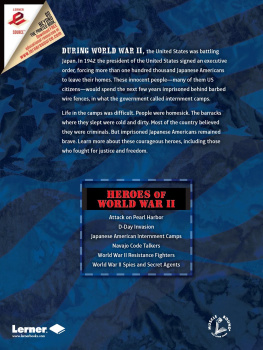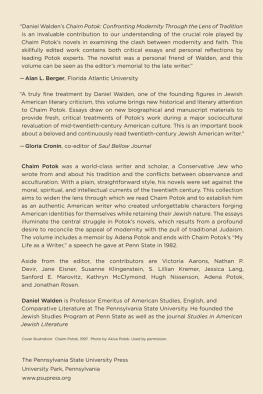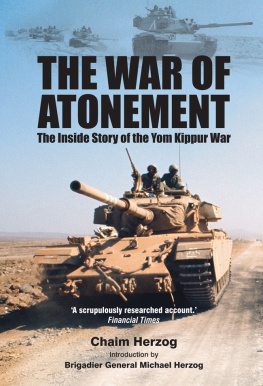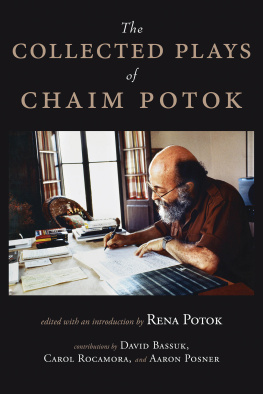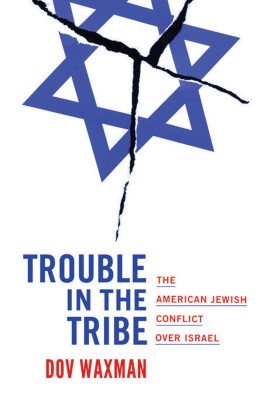Copyright 1989 by Wayne State University Press, Detroit, Michigan 48202.
All material in this work, except as identified below, is licensed under a Creative Commons Attribution-NonCommercial 3.0 United States License. To view a copy of this license, visit https://creativecommons.org/licenses/by-nc/3.0/us/.
All material not licensed under a Creative Commons license is all rights reserved. Permission must be obtained from the copyright owner to use this material.
Library of Congress Cataloging-in-Publication Data
Waxman, Chaim Isaac.
American aliya : portrait of an innovative migration movement / Chaim I. Waxman.
p. cm.
Includes index.
ISBN 978-0-8143-4342-5 (paperback);
ISBN 978-0-8143-4341-8 (ebook)
1. Jews, AmericanIsrael. 2. ZionismUnited States. 3. ImmigrantsIsrael. 4. United StatesEmigration and immigration. 5. IsraelEmmigration and immigration. 6. IsraelEthnic relations. I. Title.
DS113.8.A4W38 1989
956.94004924073dcl9 88-38114
CIP
The publication of this volume in a freely accessible digital format has been made possible by a major grant from the National Endowment for the Humanities and the Mellon Foundation through their Humanities Open Book Program.
http://wsupress.wayne.edu/
Preface
The research and writing of this book were inspired by one event and two individuals. The event was what began as a one-year sabbatical from Rutgers University and ended up as a two-year stay in Israel for me, my wife, and our children. From 1982 to 1984 we lived in Rechovot, a city south of Tel Aviv with a significant population of Americans, in which we were made to feel very welcome and in which we made many dear friends. That stay in Israel sparked my interest in several of the topics and issues covered in this book.
Just before I left for Israel, in the spring of 1982, Yehuda Rosenman, late director of the Jewish Communal Affairs Department of the American Jewish Committee and a dear friend, asked my advice about a research project on the subject of American aliya, immigration to Israel, and the return to the United States of many of those immigrants. Yehuda had a burning love for both the land and people of Israel, Eretz Israel and Am Israel, and he was one of the first American Jewish communal leaders to argue that the American Jewish community should support American aliya, that it need not fear that such aliya would deplete its future leadership; on the contrary, he argued, support for American aliya would strengthen American Jewry. At the time and in subsequent letters I told Yehuda what I felt would be necessary for such a project. He encouraged me to keep abreast of the issue of American aliya and also that of the return migration of American olim. Ultimately, Yehuda and Bert Gold, executive vice-president of the American Jewish Committee and director of its Institute on American Jewish-Israeli Relations, engaged me in a study of the return migration of American olim, upon which of this book is based. I am deeply grateful to both of them for their personal and institutional support of the subject of American aliya and for their friendship. I will sorely miss Yehuda Rosenmans wisdom, wit, and warmth; his passing was a great loss for his family, his many friends, and the entire American Jewish community.
Another dear friend who, at a later stage, was a source of encouragement and assistance in completing this book is Moshe Davis, founding director of the Hebrew Universitys Institute of Contemporary Jewry and director of the AmericaHoly Land Studies Project. His friendship and support are appreciated.
Many people assisted me in my research for this book and I wish to thank all of them. The staff at the research libraries of Rutgers University, Yeshiva University, Hebrew Union College, Jewish Theological Seminary, and the New York Public Library were very helpful. Three librarians in particular deserve special mention for assistance beyond the call of duty: Edith Lubetski, head of the Hedi Steinberg Library of Yeshiva Universitys Stern College for Women; Cyma Horowitz, director of the American Jewish Committees Blaustein Library; and Shoshana Kaufmann, Associate Director of the Paul Klapper Library of Queens CollegeCUNY. Also, Shoshana Kaufmanns compilation American Immigrants in Israel: A Selected Annotated Bibliography, 194885, published by the American Jewish Committees Institute on American Jewish-Israeli Relations, was very helpful in tracking down various books and articles on different topics.
Several other individuals gave me important technical assistance and deserve special mention. Irving (Isser) Green, president of Skan Teknologies, Inc., is much more than a friend. All else aside, the technical assistance he and his staff so graciously provided is deeply appreciated. Benjamin Sporn, attorney, and Anne D. Wade, market analyst, both of AT&T, graciously provided me with relevant telephone data. Rabbis Herschel Billet and Jay Goldberg, rabbis of the Young Israel of Woodmere and Young Israel of Wavecrest and Bayswater respectively, helped me track down several items from responsa literature. Bernice M. Salzman, editor of The Bridge, the newsletter of Parents of North American Israelis (PNAI), graciously loaned me all of the back issues of that publication. Ephraim Tabory, senior lecturer in Sociology at Bar Ilan University, kindly allowed me to refer to his as yet unpublished research on PNAI. My good friend and Bitnet correspondent in Rechovot, Ellen Wachtel, was always there to help track down information not readily available outside of Israel. Throughout the writing of this book Gershon, Suri, and Yaacov Blank, who are also much more than friends, provided me with a variety of technical assistance, all of which is deeply appreciated. And to Natalie, Naomi, Shirley, Myrna, Rita, and George, many thanks for everything. Also, the willing participation of all of the interviewees is duly noted.
Even before the book was written I had consulted with Robert A. Mandel, director of Wayne State University Press, whom I knew from his previous position. He was very supportive of the project, and he encouraged me to devote myself to it and write the book that I had initially thought would be too taxing to write on my own. For his personal concern I am very grateful. Likewise, the editorial skills and invaluable suggestions of Lois Krieger and Kathryn Wildfong are very much appreciated.
A grant from the Lucius N. Littauer Foundation enabled me to complete the manuscript on time, and I am grateful for that support. I also thank the Foundation for Middle East Peace, the Jewish Agency for Israel, the Jerusalem Center for Public Affairs, and the Sociology Department of Tel Aviv University for grants which enabled me to conduct the original research upon which is based.




